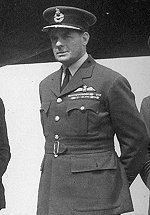Allegiance United Kingdom Rank Air marshal Education Wellington College | Name Roderick Carr Years of service 1914–1947 | |
 | ||
Born 31 August 1891Feilding, New Zealand ( 1891-08-31 ) Commands held Commander in Chief, Air Headquarters India (1946)No. 4 Group (1941–45)No. 61 Group (1940)RAF Brize Norton (1939) Battles/wars First World WarSecond World War Awards Knight Commander of the Order of the British EmpireCompanion of the Order of the BathDistinguished Flying CrossAir Force CrossMentioned in DespatchesOrder of St. Anna, 2nd Class with Swords and Bow (Russia)Order of St. Vladimir, 4th Class with Sword and Bow (Russia)Commandeur de la Legion d'honneur (France)Croix de guerre (France) Died December 15, 1971, Bampton, United Kingdom | ||
Battles and wars World War I, World War II | ||
Air Marshal Sir Charles Roderick Carr (31 August 1891 – 15 December 1971) was a senior Royal Air Force commander from New Zealand. He held high command in the Second World War and served as Chief of the Indian Air Force.
Military career
Educated at Fielding School and Wellington College, New Zealand, Carr was commissioned as a temporary flight sub-lieutenant in the Royal Naval Air Service in July 1915. He saw action as a spotter at the Battle of Loos in October 1915 during the First World War.
In 1919 he went to Russia to fight on the anti-Bolshevist side in the civil war, where he won his Distinguished Flying Cross for action against the enemy. The citation was as follows:
On the 17th June, 1919, this officer flew a scout machine over the enemy aerodrome at Puchega, at an average height of only 50 feet, for thirty minutes. During this time he succeeded in setting fire to a Nieuport enemy machine, to a hangar which contained three aeroplanes (all of which were destroyed), drove all the personnel off the aerodrome, and killed some of the mechanics.
In 1921 he was a part of Ernest Shackleton's final Antarctic expedition. On his return, he was granted an RAF short service commission in the rank of flying officer.
In 1927, Carr and Flight Lieutenant L.E.M. Gillmann attempted a non-stop flight to India, in a specially modified Hawker Horsley aircraft carrying much extra fuel and taking off at a weight of over 14,000 lb (6,350 kg). Carr and Gillmann took off from RAF Cranwell on 20 May 1927, but ran out of fuel en route, ditching in the Persian Gulf near Bandar Abbas, Iran. Despite this they had covered a distance of 3,420 mi (5,506 km), which was sufficient to set a new world distance record, but which was beaten in turn within a few hours by Charles Lindbergh's solo Atlantic flight between New York and Paris in the Spirit of St. Louis, covering 3,590 mi (5,780 km).
During the Second World War, Sir Roderick served in Bomber Command as Air Officer Commanding no. 4 Group for the majority of the war. Carr was promoted and appointed Deputy Chief of Staff (Air) at the Supreme Headquarters of the Allied Expeditionary Force in the final stages of the North West Europe Campaign. His war services were recognised with the award of Commandeur of the Legion of Honour and the Croix de Guerre by the President of France. Sir Roderick later became Air Officer Commanding, India Command ("Chief of the Indian Air Force").
In retirement, he lived in Bampton, Oxfordshire. He died at RAF Hospital Uxbridge.
